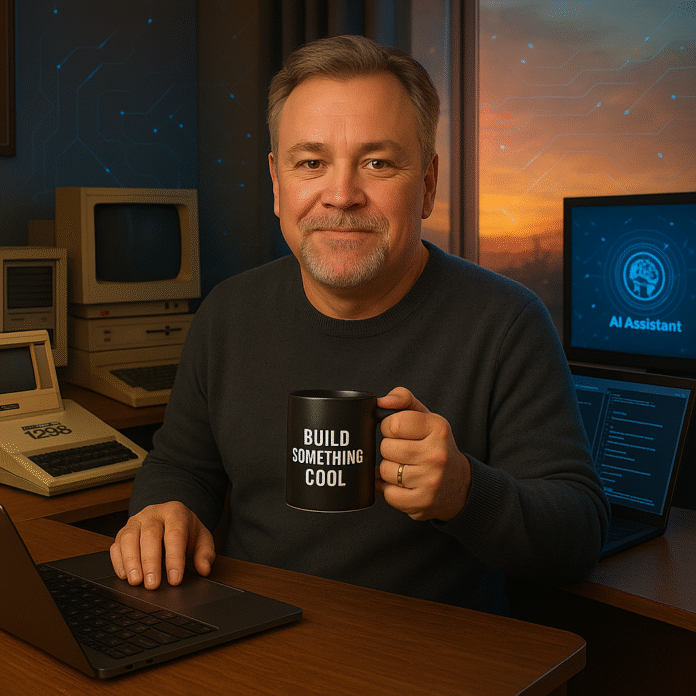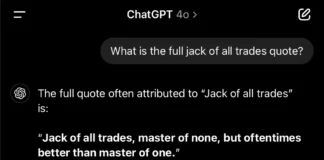This past weekend, I did something that ~ on paper ~ sounds mundane: I began moving my websites off GoDaddy and onto my own self-managed server. Big deal, right? But here’s the thing: that one sentence doesn’t tell you I rebuilt my entire digital infrastructure from the ground up. It doesn’t tell you why I did it, how I did it, or what I learned in the process. And it sure doesn’t tell you how it felt to be 56 years old, nearly 50 years into playing with computers, 40 years into working professionally with them, and still learning like I was back in high school writing code on a ZX80.
A Move That Started With a Gut Feeling
I didn’t move off GoDaddy because it was broken. I moved because I needed more control. I wanted sovereignty ~ not just over the data, but over the infrastructure, the tooling, the stack. I’ve spent the past four years back in coding full time, sharpening my technical edge. But the start of this year marked something different.
In early 2025, I left my full-time role at Givex ~ after their acquisition by Shift4 ~ and returned to full-time entrepreneurship, this time with a focused mission: build software solutions. That shift reset everything. It wasn’t a hobby anymore. It was the core of my business.
And the thread that’s run through it all ~ since the very beginning ~ is AI.
Artificial intelligence is no longer a futuristic dream~it’s a practical companion woven into my work, projects, and teaching.
The AI Thread That Started It All
In many ways, AI was the spark that started this journey for me. Back in the mid-1970s, it was the idea of artificial intelligence ~ not just computers ~ that captured my imagination and drove me to learn to code in the first place. That curiosity, that sense of wonder about machines that could “think,” became a recurring theme in my life.
Across the decades, I revisited AI again and again. Sometimes through formal experiments, sometimes through side projects or theoretical exploration. But it wasn’t until about five years ago that everything changed. AI stopped being speculative. It became practical. It moved into the mainstream.
Now, AI is woven into my daily workflow, my product stack, and my teaching. It’s not the headline ~ it’s the engine under the hood. From writing assistants to code completion, task automation to customer interactions, AI is a quiet co-pilot in nearly every aspect of what I do.
And it’s made my return to solopreneurship not just easier ~ but more fun. I’m working faster, smarter, and with more creative freedom than ever before. I no longer feel like I have to do everything myself. I feel like I have a support team, even when it’s just me and my machine.
With what we’ve seen so far, I’m genuinely excited about what’s coming next. AI isn’t replacing me ~ it’s extending me.
A Developer’s Life Reboot
Rebuilding my infrastructure was more than an IT exercise ~ it was an identity reset.
I’m not just a CXO-for-hire or someone who’s been around tech for a while. I’m someone who still wants to learn and tinker and understand. And frankly, it’s been a long time since I gave myself the space to be a student again.
I didn’t just learn how to install WordPress on a LAMP stack. I learned how to do it using Docker Compose with custom Dockerfiles, behind an NGINX reverse proxy, with Let’s Encrypt SSL, and persistent MariaDB volumes on a mounted data disk. I learned how to handle DNS routing with Cloudflare. I learned how to configure Postfix for outbound email in a Docker environment.
None of this was necessary. I could have clicked a few buttons on a managed platform. But that wasn’t the point.
The Power of Friction
There’s something magical about friction. Not the kind that slows you down unnecessarily ~ the kind that teaches you.
When I ran into UTF-8 encoding errors while debugging a CGI script, I didn’t curse Python 2.7 (okay, I did ~ but I also solved it). When I hit permissions issues or “exec format” errors because of improper line endings and missing shebangs, I fixed them. When Apache spit out cryptic logs because a module wasn’t loaded or a handler misfired, I hunted it down. Same for NGINX.
Every problem became a lesson. Every log line was a breadcrumb. Every success, however small, reinforced that I was still sharp, still capable, still able to adapt.
And as I stood up each service, one by one, I realized how far I’d come ~ because I’d forced myself to go back.
Why Learn When You Can Pay Someone Else to Do?
I’ve had people ask me this. “James, why are you doing all this? You can afford to hire someone.” And they’re right. I can.
But that’s not the point.
The point is that if I’m going to build the next chapter of my business around software again ~ if I’m going to guide others, advise others, and launch products ~ I need to be in it. Not abstracted from it.
And let’s be honest: you don’t really know what’s possible with tech until you’ve broken it a few times. You don’t know what’s fast or cheap or brittle until you’ve touched the metal.
So yes, I could outsource it. But I didn’t because the cost of not knowing is higher than the cost of learning.
After nearly five decades of tinkering with computers, I’ve come full circle.
2,000 Hours Later…
I ran the numbers last night. Between evenings, weekends, and every spare moment I could steal away from paid work, I’ve logged more than 2,000 hours since spring this year re-investing in my core technical skills. That’s the equivalent of a full work year ~ 50 weeks at 40 hours a week.
And let’s be clear: I’m not “learning to code.” I’ve been coding since the mid 1970s. I’m re-learning, modernizing, upgrading my thinking, adapting to today’s tooling. From Python 2.7 to Python 3.13. From CGI scripts to microservice APIs. From FTP uploads to Docker containers.
It’s not just that I want to keep up, it’s that I want to lead from the front.
What I Learned That Surprised Me
Here’s the thing about learning after 50: you don’t just gain knowledge, you gain perspective. And some of what I learned had nothing to do with code.
- Complexity is often a proxy for fear. The more I tried to “abstract” things, the more brittle they became. I had to face the fact that sometimes I over-engineered things to feel smarter, not to serve a real need.
- Documentation is an act of future kindness. When I returned to scripts I’d written months ago, my notes saved me hours. Not just comments, but real documentation.
- Containerization is freedom ~ but only if you treat it like plumbing. If you don’t discipline yourself, Docker can become a mess just like any other system. But done well? It’s powerful.
- You’re never too old to learn. But you are too old to lie to yourself about why you’re not.
What I Gave Up to Do This
Let’s be honest. You don’t pour 2,000 hours into skill-building without cost.
My other hobbies ~ riding my motorcycle, writing, cooking ~ have taken a back seat. Social time has been compressed. And I’ve had to make peace with the idea that some projects won’t happen on my original timeline.
But I don’t feel like I’ve lost anything. If anything, I’ve gained a deep sense of satisfaction. I’ve made peace with solitude. I’ve proven (to myself) that I can still adapt.
And I’ve laid a foundation I trust ~ because I built it myself.
This return to solopreneurship feels lighter, more creative, and infinitely more fun thanks to the support of AI.
What’s Next?
Now that the stack is live and humming, the next phase begins. I’ll be launching a few new SaaS tools over the next year. Some are skunkworks-level experiments (like “ItsDeadJim,” my power-outage alert service). Others are strategic, client-facing platforms that tie into legacy systems I’m modernizing.
But the point isn’t the tool ~ it’s the infrastructure. Because now that I own the stack, the ideas can flow. I’m no longer waiting for someone else to “set things up.” The lab is ready. The bench is stocked. The circuits are hot.
All that’s left is to build.
Final Thoughts: Why This Still Matters at 56
Tech changes. We know that. But what I’ve rediscovered is that our capacity doesn’t have to fade. Sure, it might take longer sometimes to absorb new syntax or frameworks. But the patterns, the logic, the wisdom ~ that deepens with age.
And if you’re willing to be the student again ~ to drop the ego and pick up the manual ~ you’ll be amazed at what you can still do.
So here I am. 50 years after I first touched a keyboard. 40 years into a tech career. 2,000 hours into a personal reset. And I’ve never felt more excited about what’s next.
#StayFrosty! and go build something cool.
Q&A Summary:
Q: Why did the author decide to move his websites off GoDaddy and onto his own server?
A: The author wanted more control over his infrastructure, data, and tooling. He also wanted to continue learning and honing his technical skills.
Q: What role does AI play in the author's work?
A: AI is a critical part of the author's daily workflow, product stack, and teaching. It assists in various aspects of his work, including writing, code completion, task automation, and customer interactions. It also makes his work more fun and efficient.
Q: What did the author learn while rebuilding his infrastructure?
A: The author learned various technical aspects such as how to install WordPress on a LAMP stack using Docker Compose with custom Dockerfiles, how to handle DNS routing with Cloudflare, and how to configure Postfix for outbound email in a Docker environment. He also gained perspective on the importance of documentation and realized that complexity is often a proxy for fear.
Q: What sacrifices did the author make to reinvest in his technical skills?
A: The author put his other hobbies, like riding his motorcycle, writing, and cooking, on the back burner. He also reduced his social time and had to be okay with some projects not happening on his original timeline.
Q: What is the author's next plan?
A: The author plans to launch new SaaS tools over the next year. Some of these tools are experimental, while others are strategic, client-facing platforms that tie into legacy systems he is modernizing.


